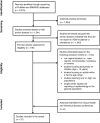Systematic review of the incidence and prevalence of genital warts
- PMID: 23347441
- PMCID: PMC3618302
- DOI: 10.1186/1471-2334-13-39
Systematic review of the incidence and prevalence of genital warts
Abstract
Background: Anogenital warts (AGWs) are a common, highly infectious disease caused by the human papillomavirus (HPV), whose high recurrence rates contribute to direct medical costs, productivity loss and increased psychosocial impact. Because of the lack of a systematic review of the epidemiology of AGWs in the literature, this study reviewed the published medical literature on the incidence and prevalence of AGWs.
Methods: A comprehensive literature search was performed on the worldwide incidence and prevalence of AGWs between 2001 and 2012 using the PubMed and EMBASE databases. An additional screening of abstracts from relevant sexual health and infectious disease conferences from 2009 to 2011 was also conducted. Only original studies with general adult populations (i.e., at least including ages 20 through 40 years) were included.
Results: The overall (females and males combined) reported annual incidence of any AGWs (including new and recurrent) ranged from 160 to 289 per 100,000, with a median of 194.5 per 100,000. New AGW incidence rates among males ranged from 103 to 168 per 100,000, with a median of 137 per 100,000 and among females from 76 to 191 per 100,000, with a median of 120.5 per 100,000 per annum. The reported incidence of recurrent AGWs was as high as 110 per 100,000 among females and 163 per 100,000 among males. Incidence peaked before 24 years of age in females and between 25 and 29 years of age among males. The overall prevalence of AGWs based on retrospective administrative databases or medical chart reviews or prospectively collected physician reports ranged from 0.13% to 0.56%, whereas it ranged from 0.2% to 5.1% based on genital examinations.
Conclusions: The literature suggests that AGWs are widespread and the prevalence depends on study methodology as suggested by higher rates reported from routine genital examinations versus those from treatment records. However, there remains a need for more population-based studies from certain regions including Africa, Latin America and Southern Asia to further elucidate the global epidemiology of this disease.
Figures
References
Publication types
MeSH terms
LinkOut - more resources
Full Text Sources
Other Literature Sources
Medical




